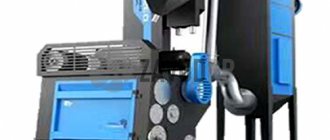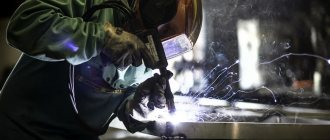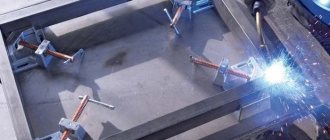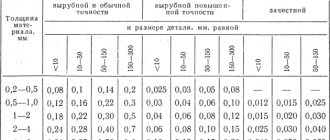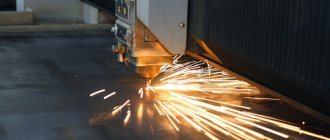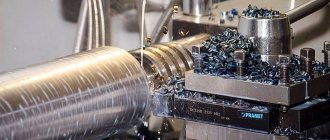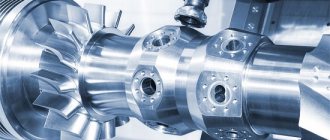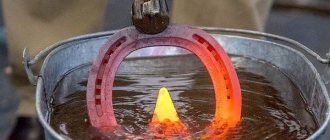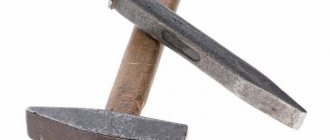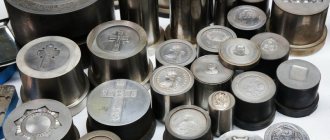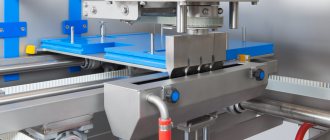Metal processing is a process aimed at changing the shapes, sizes and appearance of products. To implement the project, a certain set of tools is used. Regarding metal, various types of machines and additional devices may be needed.
- Methods and stages First stage. Creating a mold or blank
- Second phase. Parts processing
- Third stage. Assembly of the structure
Features of metal processing
Numerous types of metalworking can be classified into one of the large groups:
- mechanical (cutting);
- casting;
- thermal;
- pressure;
- welding;
- electric;
- chemical
Casting is one of the most ancient methods. It consists of melting metal and pouring it into a prepared mold that repeats the configuration of the future product. This method produces durable castings of various sizes and shapes.
Other types of processing will be discussed below.
Casting
The essence of the method is that molten metal is poured into pre-prepared molds. The resulting part is called a casting.
The casting production process consists of the following basic steps:
- Preparation of mixtures.
- Production of casting molds and cores.
- Assembly and pouring.
- Removing castings from molds and subsequent processing.
Casting is used to produce a wide range of parts - equipment frames, cylinder blocks, heating radiators and others.
For the manufacture of castings, cast iron, steel, and non-ferrous metals are used. Most often from the above list, cast iron casting alloy is used. This is the cheapest material and has a low melting point.
The mold for making the casting is assembled from molding earth or using a flask made of metal or wood.
The development of foundry is constantly evolving and the number of technologies is growing, in particular, methods such as pressure casting, chill casting, and lost wax molds are widely used. This makes it possible to obtain castings that do not require further processing, and this leads to a reduction in the cost of the finished product.
Welding
Welding has also been known to man since ancient times, but most of the methods were developed in the last century. The essence of welding is to connect the edges of two parts heated to the plasticity temperature or to the melting temperature into a single integral whole.
Depending on the method of heating the metal, several groups of welding technologies are distinguished:
- Chemical. The metal is heated by the heat released during the chemical reaction. Thermite welding is widely used in hard-to-reach places where it is impossible to supply electricity or haul gas cylinders, including under water.
- Gas. The metal in the welding zone is heated by the flame of a gas burner. By changing the shape of the torch, you can carry out not only welding, but also cutting of metals.
- Electric welding. The most common method: Arc welding uses the heat of an electric arc to heat and melt the work area. Special welding machines are used to ignite and maintain the arc. Welding is carried out using spatter electrodes or special welding wire in an atmosphere of inert gases.
- In resistance welding, heating is carried out by a strong electric current passing through the point of contact of the workpieces being joined. There are spot welding, in which parts are connected at individual points, and roller welding, in which a conductive roller rolls along the surface of the parts and connects them with a continuous seam.
Arc welding
Welding is used to connect machine parts, building structures, pipelines, ship and car hulls, and much more. Welding goes well with other types of metal processing.
New technologies for metal surface treatment at the exhibition
At the exhibition "Metalworking"
Leading experts in the metal processing industry, including surface treatment technologies, will be brought together. Experts will talk about the prospects for the development of the industry and plans for the future, as well as new methods and technologies for improving the cleanliness of metal surface treatment.
The Metalworking exposition is an annual industry event in heavy industry. It is dedicated to new special equipment and innovative technologies, as well as their application in the industry.
Electrical processing
The method is based on the partial destruction of metal parts under the influence of high-intensity electrical discharges.
It is used for burning holes in thin sheet metal, when sharpening tools and processing workpieces made of hard alloys. It also helps to remove a broken or stuck tip of a drill or threaded tap from a hole.
A graphite or brass electrode, to which high voltage is applied, is brought to the processing site. A spark jumps, the metal partially melts and spatters. To trap metal particles, the gap between the electrode and the part is filled with special oil.
Ultrasonic metal processing
Electrical methods of metal processing also include ultrasonic. High intensity vibrations with a frequency of over 20 kHz are excited in the part. They cause local resonance and point destruction of the surface layer; the method is used for processing durable alloys, stainless steel and jewelry.
Basic processing methods
The basics of metalworking are necessary for any novice craftsman and foundry worker to know. Knowing how certain metals behave under different processing methods, you can avoid mistakes when carrying out the technological process.
Modern metalworking includes several main areas of processing:
- Electric. Using this method, you can make holes in metal sheets for sharpening tools and working with hard types of steel.
- Mechanical. An extensive group of methods for processing metal workpieces. They are processed using special equipment.
- Chemical. Creating an artificial chemical reaction using acids, alkalis and other components.
- Working with pressure. In order not to violate the integrity of the workpiece and change its shape, equipment is used that creates powerful pressure. To change the shape of a workpiece made of hard steel, the material is initially heated.
- Thermal. To improve the technical characteristics of the material, various methods of temperature processing of workpieces are used.
Metalworking technology is developing and improving every year. New equipment and options for working with metals are emerging.
What determines the type of processing?
Types of metalworking involve different ways of working with metals. Each method is selected depending on the hardness of the material and its other characteristics. This is also influenced by what needs to be done with the workpiece. For example, heat treatment is used to change the technical characteristics of a material. To change the shape of the workpiece, a mechanical method or injection pressure equipment can be used.
Features of artistic metal processing
Artistic types of metal processing include casting, forging and embossing. In the middle of the 20th century, welding was added to them. Each method requires its own tools and devices. With their help, the master either creates a separate work of art, or additionally decorates a utilitarian product, giving it aesthetic content.
Artistic embossing
Embossing is the creation of a relief image on the surface of a metal sheet or the finished product itself, for example, a jug. Embossing is also done on heated metal.
Methods of mechanical processing of metals
A large group of methods for machining metals have one thing in common: each of them uses a sharp and hard tool in relation to the workpiece, to which mechanical force is applied. As a result of the interaction, a layer of metal is separated from the part, and its shape changes. The workpiece exceeds the dimensions of the final product by an amount called “allowance”
There are such types of mechanical processing of metals as:
- Turning. The workpiece is fixed in a rotating tooling, and a cutter is brought to it, removing a layer of metal until the dimensions specified by the designer are reached. Used for the production of parts shaped like a body of revolution.
- Drilling. A drill is immersed into a stationary part, which quickly rotates around its axis and is slowly fed towards the workpiece in the longitudinal direction. Used for making round holes.
- Milling. Unlike drilling, where processing is carried out only with the front end of the drill, the side surface of the cutter is also working, and in addition to the vertical direction, the rotating cutter moves both right and left and back and forth. This allows you to create parts of almost any desired shape.
- Planing. The cutter moves back and forth relative to the stationary part, each time removing a longitudinal strip of metal. In some machine models, the cutter is fixed and the part moves. Used to create longitudinal grooves.
- Grinding. The processing is carried out by rotating or performing longitudinal reciprocating movements with an abrasive material that removes thin layers from the surface of the metal. It is used for treating surfaces and preparing them for coating.
Metal grinding
Each operation requires its own special equipment. In the technological process of manufacturing a part, these operations are grouped, alternated and combined to achieve optimal productivity and reduce intra-shop costs.
Pressure treatment
Metal forming is used to change the shape of a part without compromising its integrity. The following types exist:
- Stamping.
- Forging.
Before forging, the workpiece is heated, supported on a hard surface, and a series of blows are applied with a heavy hammer so that the workpiece takes the desired shape.
Historically, forging was done by hand; the blacksmith heated the piece in the flame of a forge, grabbed it with tongs and placed it on an anvil, and then hit it with a smith's hammer until a sword or horseshoe was made. A modern blacksmith acts on a workpiece with a hammer from a forging press with a force of up to several thousand tons. Billets up to tens of meters long are heated in gas or induction furnaces and fed to the forging plate by transport systems. Instead of a hand hammer, forging dies made of high-strength steel are used.
Forging
For stamping, two forms are required that are mirrored in relation to each other - a matrix and a punch. A thin sheet of metal is placed between them, and then moved with great force. The metal, bending, takes the form of a matrix. For large sheet thicknesses, the metal is heated to the point of plasticity. This process is called hot stamping.
During stamping, operations such as:
- flexible;
- pulling;
- settling;
- and others.
Stamping is used to produce a wide range of products - from household appliance housings to wheel rims and gas tanks.
Ultrasonic processing of metal parts
This technology is one of the types of mechanical processing of metal parts. Its essence boils down to the fact that under the influence of ultrasound the top layer of the material is destroyed. The treatment is not carried out by ultrasound itself, but by a mixture of abrasive particles that are driven by sound with a frequency of 16 to 30 kHz. The sound is produced by the blows of a special instrument.
In this case, abrasive particles act as cutting tools, so they are subject to increased requirements for hardness. Thus, ultrasonic processing uses small particles of boron carbide, electrocorundum, etc.
Using ultrasonic processing, it is possible to form a metal part along a through contour using a special hollow tool. In addition, ultrasonic processing technology makes it possible to process blind holes of various shapes, and at the same time achieve high precision and cleanliness of the processed surface.
If you use ultrasonic vibration technology during the grinding process with a conventional diamond wheel, you can achieve a higher surface quality and eliminate defects associated with grinding. The processing speed of metal parts during ultrasonic processing depends on indicators such as density, hardness, shape and size of the workpiece, as well as the type of abrasive particles and modes used in the processing process.
Processing by cutting
The metal is supplied to the enterprise in the form of rolled products - sheets or profiles of standard sizes and thicknesses. To separate a sheet or profile into products or blanks of the required size, cutting processing is used.
For profiles, cutting with an abrasive wheel or circular saw is most often used.
Several types of cutting are used for cutting metal sheets:
- Manual. A gas welder with a gas torch cuts out pieces of metal of the required size and shape. It is used in small workshops and pilot production.
- Gas. The gas cutting installation cuts with the flame of an automated gas burner and allows you not only to quickly cut sheets, but also to arrange the cut pieces into containers for delivery to assembly areas
- Laser. Cuts metal with a laser beam. It features high accuracy and low waste ratio. In addition to cutting, it can perform welding and engraving operations - applying permanent inscriptions to metal.
- Plasma. Cuts metal with a torch of highly ionized gas - plasma. Used for cutting sheets of hard and special alloys.
Laser cutting
In conditions of industrial production and medium or large series, the concept of metal utilization rate comes to the fore. It is increased both due to a denser arrangement of parts over the area and due to advanced cutting technologies that produce less waste
Chemical processing of metals to increase the protective properties of the material
Chemical treatment of metal is the action of special substances on it in order to cause a controlled chemical reaction.
They are performed both as preparatory operations to clean the surface before welding or painting, and as finishing operations to improve the appearance of the product and protect it from corrosion.
Metal galvanizing
Protective coatings are applied using electrochemical treatment using the galvanic method.
Thermal types of metal processing
Heat treatment of metals is used to improve their physical and mechanical properties. This includes operations such as:
- annealing;
- hardening;
- vacation;
- aging;
- normalization.
Heat treatment of steel
Heat treatment involves heating a part to a certain temperature and then cooling it according to a special program.
Annealing
The workpiece is heated to the plasticity temperature and slowly cooled directly in the furnace.
Annealing reduces the hardness of steel, but significantly increases ductility and malleability.
Annealing
Used before stamping or rolling. During annealing, internal stresses that arise during casting or machining are relieved.
Hardening
When hardening, the workpiece is heated to the plasticity temperature and kept in this state for a certain time, during which the internal structures of the metal are stabilized. Next, the product is quickly cooled in a large amount of water or oil. Hardening significantly increases the hardness of the material and reduces its impact strength, thereby increasing brittleness. Used for structural elements subject to large static and small dynamic loads.
Vacation
Carried out after hardening. The sample is heated to a temperature slightly lower than the quenching temperature and cooled slowly. This allows you to compensate for the excessive fragility that appears after hardening. Used in tool production
Aging
Artificial aging involves stimulating phase transformations in the metal mass. It is carried out with moderate heating to give the material properties that arise during natural aging over a long time.
Chemical and mechanical treatment
Thermal methods are used using chemistry to saturate the metal with elements, such as carbon. This method of exposure is called chemical-thermal. And if the product is mechanically affected during the cooling process, giving it the desired shape, then this is thermomechanical processing.
Welding
Strong connection of two or more metal parts to each other.
When welding, the product is heated at the site of the intended seam until it melts. The atoms of the parts being joined are then mixed, forming a seam as they cool.
Under normal conditions, it is impossible to connect parts by squeezing them together; the fact is that the surface of the metal is contaminated with various substances. When the material heats up and melts, fresh layers of metal are released, so their connection becomes possible.
There are three types of welding:
- thermal,
- thermomechanical,
- mechanical.
Thermal or thermal effects on parts involve heating without the application of additional pressure. Heat is obtained from an electric arc (electrical effect), gas flame.
With thermomechanical joining, the parts are heated only to the point of their plasticity, after which they are tightly connected, squeezing each other.
Pressure welding deforms the metal to such an extent that it begins to flow like water.
Pressure Welding
The contaminated layers drain away, revealing a fresh layer. A chemical reaction then begins, joining the parts together.
This process occurs only with the use of automation. A person does not have sufficient strength to lead to such reactions. This welding is applicable when you need to connect large parts with thick walls.
Manual welding
In everyday life, portable welding machines are more often used, capable of welding structures made of metals of small thickness. The principle of electric arc is used here.
Using a special electrode, a short circuit is caused to the workpiece being welded. A stable arc discharge of about 6 thousand degrees Celsius occurs. Then, at a distance of 2–5 millimeters between the electrode and the product, the welding process occurs. The result is a strong seam that can withstand great external pressure.
Submerged arc welding
In production conditions, automatic submerged arc welding is used.
Submerged Arc Welding Process
It is poured onto the products to be welded in a layer of 50–60 millimeters. Then start welding.
First, the flux itself is heated, and welding occurs in the flux gas environment, while the metal itself is not exposed to oxygen. The seam of such welding is stronger than manual welding.
Pressure treatment
To give the future product the desired shape, during the manufacture of semi-finished products and parts, pressure is applied to it. In this case, the properties of the material do not change, only the shape changes.
There are the following methods of applying pressure:
- forging,
- stamping,
- sheet stamping,
- rolling,
- pressing,
- drawing.
Forging
The oldest processing method is forging. The metal is heated to a plastic state, after which it is given the desired shape using special tools. In ancient times, blacksmiths used forging to make weapons, tools, and tools. Nowadays forging is used more in architecture, when creating patterns for gates and staircase handrails.
Forging is also possible without preheating. The desired shape is given by bending it in a certain way. With this method, additional processing of the metal will be necessary, because errors in the work appear.
Stamping
Automated process using machines. The future part is either placed in a special mold, after which it is subjected to pressure, or it is impacted with a stamp of a given shape. In the first case, three-dimensional products are obtained, in the second, sheet metal is used.
When rolling, the metal is passed between two rotating rollers. The output is smooth sheets. The drawing process is similar to rolling, however, the result is not sheets, but wire. The combined effect of pressure on the metal is also used.
Electrical processing
One of the last stages of processing.
It is used to clean the surface of a product from corrosion, polish it, and add shine. It is exposed to electric current with temperatures up to 10 thousand degrees.
This metal processing is used for particularly hard alloys that require jewelry work and cannot be treated by other means. All stages of the process are carried out scrupulously, maintaining the necessary conditions to obtain high-quality material.
Electrical processing is also used to cut out small holes and notches in the product, and make engravings.

